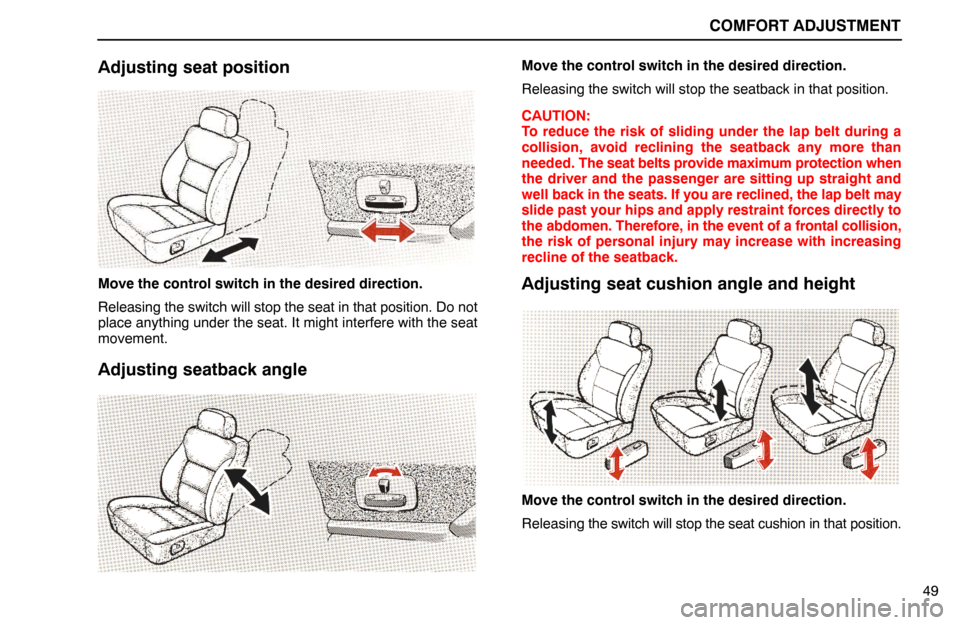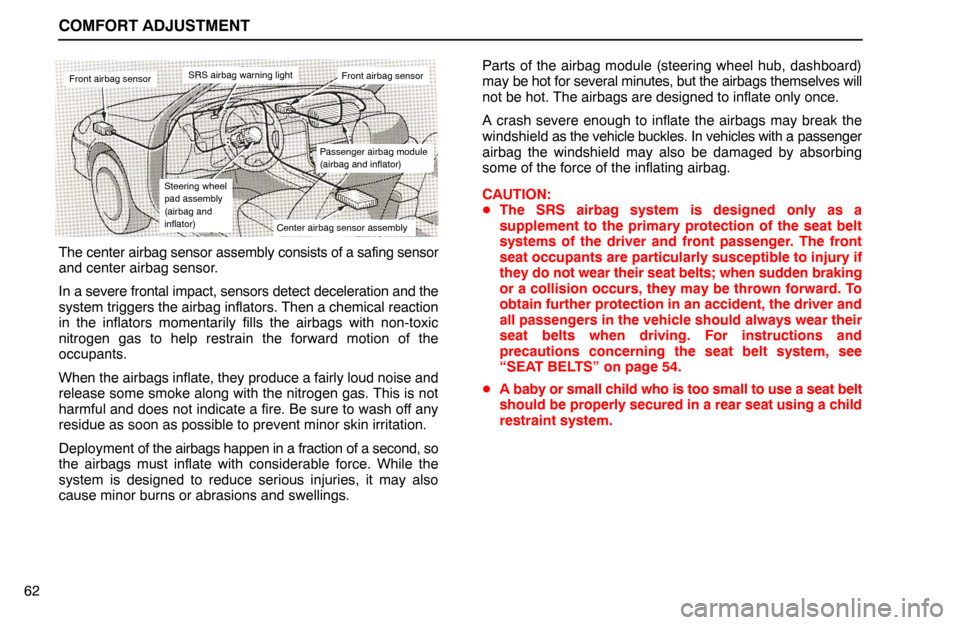Page 2 of 28
COMFORT ADJUSTMENT
48
FRONT SEATS
Seat adjustment precautions
Adjust the driver’s seat so that the foot pedals, steering wheel
and instrument panel controls are within easy reach of the
driver.
CAUTION:
�Do not adjust the seat while the vehicle is moving as the
seat may unexpectedly move and cause the driver to
lose control of the vehicle.
�Be careful not to hit the seat against a passenger,
luggage or the rear seat.
NOTICE:
Do not operate the control switch in more than one
dimension at a time. It may cause electrical overload.
Adjusting front seats
Seat position control switch,
seat cushion angle and height
control switch
Seatback angle
control switch
Page 3 of 28

COMFORT ADJUSTMENT
49
Adjusting seat position
Move the control switch in the desired direction.
Releasing the switch will stop the seat in that position. Do not
place anything under the seat. It might interfere with the seat
movement.
Adjusting seatback angle
Move the control switch in the desired direction.
Releasing the switch will stop the seatback in that position.
CAUTION:
To reduce the risk of sliding under the lap belt during a
collision, avoid reclining the seatback any more than
needed. The seat belts provide maximum protection when
the driver and the passenger are sitting up straight and
well back in the seats. If you are reclined, the lap belt may
slide past your hips and apply restraint forces directly to
the abdomen. Therefore, in the event of a frontal collision,
the risk of personal injury may increase with increasing
recline of the seatback.
Adjusting seat cushion angle and height
Move the control switch in the desired direction.
Releasing the switch will stop the seat cushion in that position.
Page 4 of 28
COMFORT ADJUSTMENT
50
Adjusting lumbar support
(driver’s seat only)
Pull the lever forward and release it.
Repeat this until you have comfortable support.
TRUNK STORAGE EXTENSION
Lock
Open
Unlock
Pull down the center armrest in the rear seat. Pull the lever
of the armrest door and open the armrest door.
Access to the trunk can be prevented by locking the armrest
door with the master key.
Page 8 of 28

COMFORT ADJUSTMENT
54
SEAT BELTS
Seat belt precautions
Lexus recommends that the driver and passengers in the
vehicle be properly restrained at all times with the seat belts
provided. Failure to do so could increase the chance of injury
and / or the severity of injury in accidents.
Baby or small child. Use a child restraint system which fits
your vehicle. See “Child restraint” for details.
Child. If a child is too large for a child restraint system, the child
should sit in the rear seat and must be restrained using the
vehicle’s seat belts. According to accident statistics, the child
is safer when properly restrained in the rear seat than in the
front seat. Do not allow the child to stand up or kneel both on
rear and front seats. If the shoulder belt falls across the child’s
neck or face, move the child to the center position and use the
center lap belt.
Pregnant woman. Lexus recommends the use of a seat belt.
Ask your doctor for specific recommendations. The lap belt
should be worn securely and as low as possible over the hips
and not on the waist.
Injured person. Lexus recommends the use of a seat belt.
Depending on the injury, however, first check with your doctor.CAUTION:
Persons should ride in their seats properly wearing their
seat belts whenever the vehicle is moving. Otherwise,
they are much more likely to suffer serious bodily injury
in the event of sudden braking or a collision.
When using the seat belts, observe the following:
�Use the belt for only one person at a time. Do not use
a single belt for two or more people − even children.
�Avoid reclining the seatbacks too much. The seat belts
provide maximum protection when the seatbacks are in
the upright position. (See “Adjusting seatback angle”.)
�Be careful not to damage the belt webbing or hardware.
Take care that they do not get caught or pinched in the
seat or doors.
�Inspect the belt system periodically. Check for cuts,
fraying, and loose parts. Damaged parts should be
replaced. Do not disassemble or modify the system.
�Keep the belts clean and dry. If they need cleaning, use
a mild soap solution or lukewarm water. Never use
bleach, dye, or abrasive cleaners − they may severely
weaken the belts.
�Replace the belt assembly if it has been used in a
severe impact. The entire assembly should be replaced
even if damage is not obvious.
Page 14 of 28
COMFORT ADJUSTMENT
60
SRS AIRBAGS
The SRS (Supplemental Restraint System) airbags are
designed to provide further protection to the driver and
front passenger when added to the primary protection
provided by the seat belts.
In response to a severe frontal impact, the SRS airbags
work together with the seat belts to prevent or reduce
injury by inflating, in order to decrease the likelihood of
the driver’s or front passenger’s head or face directly
hitting the steering wheel or dashboard.
The passenger airbag is activated even with no passenger in
the front seat.
This indicator comes on when the ignition key is turned to
the “ACC” or “ON” position. It goes off after about 6
seconds. This means the SRS airbags are operating
properly.
The SRS airbag warning light system monitors the front airbag
sensors, center airbag sensor assembly, inflators, warning
light, interconnecting wiring and power sources.
Page 16 of 28

COMFORT ADJUSTMENT
62
Front airbag sensor
Steering wheel
pad assembly
(airbag and
inflator)
SRS airbag warning light
Passenger airbag module
(airbag and inflator)
Center airbag sensor assembly
Front airbag sensor
The center airbag sensor assembly consists of a safing sensor
and center airbag sensor.
In a severe frontal impact, sensors detect deceleration and the
system triggers the airbag inflators. Then a chemical reaction
in the inflators momentarily fills the airbags with non-toxic
nitrogen gas to help restrain the forward motion of the
occupants.
When the airbags inflate, they produce a fairly loud noise and
release some smoke along with the nitrogen gas. This is not
harmful and does not indicate a fire. Be sure to wash off any
residue as soon as possible to prevent minor skin irritation.
Deployment of the airbags happen in a fraction of a second, so
the airbags must inflate with considerable force. While the
system is designed to reduce serious injuries, it may also
cause minor burns or abrasions and swellings.Parts of the airbag module (steering wheel hub, dashboard)
may be hot for several minutes, but the airbags themselves will
not be hot. The airbags are designed to inflate only once.
A crash severe enough to inflate the airbags may break the
windshield as the vehicle buckles. In vehicles with a passenger
airbag the windshield may also be damaged by absorbing
some of the force of the inflating airbag.
CAUTION:
�The SRS airbag system is designed only as a
supplement to the primary protection of the seat belt
systems of the driver and front passenger. The front
seat occupants are particularly susceptible to injury if
they do not wear their seat belts; when sudden braking
or a collision occurs, they may be thrown forward. To
obtain further protection in an accident, the driver and
all passengers in the vehicle should always wear their
seat belts when driving. For instructions and
precautions concerning the seat belt system, see
“SEAT BELTS” on page 54.
�A baby or small child who is too small to use a seat belt
should be properly secured in a rear seat using a child
restraint system.